Capital: Belgrade
Population: 7,334,995
Currency: Serbian Dinar
Official Language: Serbian
Borders: Hungary (north); Romania and Bulgaria(east); Republic of Macedonia (south); Croatia, Bosnia and Herzegovina, Montenegro (west) its border with Albania is disputed
GNP per Capita: $10,810 (70th in world)
Main Airport: Belgrade’s Niko Tesla International
Although landlocked, Danube river provides Serbia with an access to the Black Sea. Its capital city, Belgrade, is among the largest in Southeastern Europe. In February 2008, the parliament of Kosovo, Serbia’s southern province with an ethnic Albanian majority, declared independence. The response from the international community has been mixed. Serbia regards Kosovo as its autonomous province govermend by UNMIK, a UN mission.
After their settlement in the Balkans, Serbs formed a medieval kingdom that evolved into a Serbian Empire, which reached its peak in the 14th century. By the 16th century Serbian lands were conquered and occupied by Ottomans. Serbia regained independence from the Ottoman Empire in a 19th century revolution and subsequently regained some of its territory. Serbia was the second state in Europe that abolished feudalism and serfdom. Former Habsburg crownland of Vojvodina joined Serbia in 1918. Following the end of World War I, the country united with other South Slavic peoples into a Yugoslav state which would exist in several formations up until 2006, when Serbia once again became independent.
 Serbian clubs used to compete in the Yugoslav First League. This competition was formed in 1923 and lasted until 2003. After the downfall of SFR Yugoslavia in 1991 a new Yugoslavia would be formed that would be named FR Yugoslavia with Montenegro and Serbia. They kept the name Yugoslavia until 2003 when the country changed its name to Serbia and Montenegro: this union lasted until 2006 whenMontenegro gained independence and formed its own league, the Montenegrin First League. left: OFK’s Omladinski Stadium
Serbian clubs used to compete in the Yugoslav First League. This competition was formed in 1923 and lasted until 2003. After the downfall of SFR Yugoslavia in 1991 a new Yugoslavia would be formed that would be named FR Yugoslavia with Montenegro and Serbia. They kept the name Yugoslavia until 2003 when the country changed its name to Serbia and Montenegro: this union lasted until 2006 whenMontenegro gained independence and formed its own league, the Montenegrin First League. left: OFK’s Omladinski Stadium
The current SuperLiga champions are Partizan. UEFA currently ranks the league 21st in Europe.[1] The league was known as Meridian SuperLiga from Autumn 2004 until Summer 2008. The league’s current official sponsor is beer maker Jelen pivo, thus resulting in the league’s official name to be Jelen SuperLiga.
The Yugoslav First League (as it was then known) was formed in 1992 and is currently contested by twelve clubs from across Serbia. In a total of fifteen seasons, the title has been won by only three teams: Partizan (eight times), Crvena Zvezda (six times), and Obilić (once). The current Superliga champions are Partizan Belgrade. UEFA currently ranks the league 20th in Europe.
 Format
Format
The Superliga title holder begins its UEFA Champions League campaign in the second round of qualifying as a seeded team.
left: Kula’s Hadjuk Stadium
The second, third and fourth placed teams begin in the Europa League first round of qualifying also as seeded teams.
 The last two teams at the end of the season get relegated to the Second Division known as Prva Liga Telekom Srbija. The team holding 10th position at the end of the season is not automatically relegated. It plays against the winner from the Prva Liga Telekom Srbija playoff in a two-legged matchup. Above – FK Sartid’s Kraj Stadion.
The last two teams at the end of the season get relegated to the Second Division known as Prva Liga Telekom Srbija. The team holding 10th position at the end of the season is not automatically relegated. It plays against the winner from the Prva Liga Telekom Srbija playoff in a two-legged matchup. Above – FK Sartid’s Kraj Stadion.
The Superliga will change format starting from the 2007-08 season. The league will no longer be divided into a playoff and playout group midway through the campaign. Instead, the 12 teams will play each other three times in a conventional league format.
 History
History
The Superliga was known as the Yugoslav First League after its creation in 1992. In 2003, Yugoslavia was renamed to Serbia and Montenegro and the football league followed suit.
Left: Stadion Mladost in Krusavec
The First League of Serbia and Montenegro contained 16 teams, but the current Superliga has only 12 in an attempt to bring up the level of play. The Football Association of Serbia questionned their decision prior to the 2007-08 season but have decided that there will be no changes in the number of teams.
The first official kick-off under the name of Meridian Superliga was on August 5, 2006. Crvena Zvezda are the current defending champions and are officially the first Serbian champions. Last season the title was taken by city rivals Partizan, holding off the challenge of Red Star.
The following twelve clubs are currently competing in the Serbian Superliga.
BSK Borča – Belgrade – Borča Stadium – Capacity: 3,500.SK Borča football club was founded in April, 1937. The club has chiefly competed in the lower (regional) leagues of the Belgrade area. The arrival of new leadership in the mid-1990s and, as of 2003, the new investments into the club have significantly contributed to the club’s expansion into a serious sports organization. The club’s worst seasons since its founding were between 1990 and 1992, when it went down from the Belgrade Zone to First Division Belgrade, and lastly to the Second Division Belgrade, the lowest category of the competition. KK BSK finished first in the 2008/09 season of the Serbian First League and won promotion into the Serbian Superliga.
FK Borac Čačak -Čačak -Čačak Stadium – Capacity: 6,000
Fifth last season was a good return from years of development for this small side. In the 2005/06 season, FK Borac finished in the 7th place which was the best result in the history of the club. However, in the 2007/08 season went even further. Finished 4th, the club for the first time provide a place in European competition, ie. UEFA Cup. They had a very successful run – they defeated Dacia Chişinău from Moldova in the first qualifying round (4-2 on aggregate) and Lokomotiv Sofia from Bulgaria in the second qualifying round (2-1 on aggregate). FK Borac then challenged Dutch giants Ajax in the 1st round and were eliminated after defeats in both games 1-4 in Belgrade and a 0-2 in Amsterdam.
FK Čukarički Stankom – Belgrade – Cukarički Stadium – Capacity: 7,000
The club had emerged from Čukarica, a City of Belgrade municipality on the Sava River’s right bank, around a factory sugar-house, craft factory of boats. The club was formed on July 4, 1926. From a bar, Majdan, the club was given the name: ČSK “Čukarički Casual Club. The club colors have been black and white, it is a tradition which is still present. In the Yugoslav Cup in 1995, FK Čukarički came into the quarterfinals and also competed in the UEFA Intertoto Cup in the 1996 season and the 1997 season. Their biggest recent success came in the 1999/2000 season when they finished 6th in the First Yugoslav League. Later on, a big company called Stankom became the club’s sponsor and brought a better organization, increased the stadium capacity to 7,000 and also brought a better financial situation. The future looks good for FK Čukarički. The club competes in the Serbian Superliga, after being promoted from the Second Division.
 FK Hajduk Kula – Kula – Hajduk Stadium – Capacity: 11,000
FK Hajduk Kula – Kula – Hajduk Stadium – Capacity: 11,000
The club was founded in 1925. The club was known as FK Hajduk Kula until 1992 when the club changed its name to FK Hajduk Rodić M&B and competed in lower divisions. Club colors are blue and white. Hajduk plays on Stadion Hajduk which has capacity of 11,000 seats. The club’s great success was finishing fourth in the 1996/97 season in First League of FR Yugoslavia and the quarterfinals of the 1997 Yugoslavian Cup competition. The best result in European competitions was the 1997 UEFA Intertoto Cup where Hajduk finished in second place in their group with 2 wins and 2 losses.
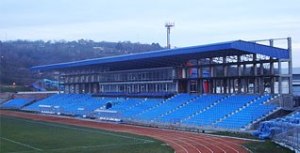 FK Jagodina – Jagodina – FK Jagodina Stadium – Capacity: 15,000
FK Jagodina – Jagodina – FK Jagodina Stadium – Capacity: 15,000
The club was formed in 1918 as SK Dača, then changed its name to SK Jagodinski, followed by FK Polet, before finally becoming FK Jagodina in 1981. For the 2008-09 season FK Jagodina gained the right to, for the first time in its history, compete in the country’s top football league – Jelen Super Liga. The club did so by finishing second in the Serbian Prva liga 2007-08 season thus earning itself a direct spot in the top league. The club’s chairman Dragan “Palma” Marković announced that the club received € 100,000 from an Austrian sponsor. The club stated high ambitions by beating Red Star and Partizan at Jagodina Stadium and wants to qualify for the UEFA Cup. The club’s previous top result was qualifying for the Serbian first league in 1944, but it was not held the following season
FK Javor Ivanjica – Ivanjica – Ivanjica Stadium – Capacity: 5,000
4th Place last season for the team from Ivanjica. The greatest success in the history of maple makes the 2001/02 season when entering the first Federal League, and the 90-year anniversary of the club.The president of the club Dusko Sekulic and three Vice-President Dragan Lazovic, Darko Jovanovic Bešević and Freedoms, were at the head of the club and set temalje recent history of the club.
FK Metalac Gornji Milanovac – FK Metalac Stadium – Capacity: 3,000
Promoted via the play offs last season after finishing 5th in the Second division. The club was founded in 1961. Gornji Milanovac lies between mountains Rudnik to the north and Vujan to the south. The city is situated along western side of European route E763, between the cities Ljig to the north and Čačak to the south and the villages Majdan to the north and Preljina to the south
FK Mladi Radnik – Požarevac – Vašarište – Capacity: 3,000
Located in eastern Serbia. It is the administrative center of the Braničevo District of Serbia. In 2002, the city had total population of 41,736, while the municipality had 74,902 residents.FK Mladi Radnik dates back to 1926. The oldest stored image of SK Radnički is from 1927. In the spring of 1927, SK Radnički were officially included in the football clubs of Požarevac. It was first noted on the August 2, they played a reserve team game versus FK Pobeda. The first victory of the team was recorded in September 1927, beating Hajduk 2-1. Under the name Mladi Radnik between 1928 and 1929, the club joined the Football Association of Yugoslavia. On 13 October, 1929, they played the first game against the then primary FK Pobeda. In the 1929/30 season, in the Braničevo-podunavska parish, Mladi Radnik became a full member of the official football federation, and a participant in a number of primary contests…
 FK Napredak Kruševac – Kruševac – Stadium Mladost – Capacity: 10,881
FK Napredak Kruševac – Kruševac – Stadium Mladost – Capacity: 10,881
FK Napredak is a Serbian football club based in the city of Kruševac. The club was founded on December 8, 1946, through a fusion of three local area clubs: Zakić, Badža and 14. Oktobar. The club played its first official game against FK Makedonija, a team from Skoplje, in January 1947. In domestic competitions, Napredak’s biggest success is reaching the Yugoslav Cup final in 2000, losing to Red Star Belgrade. Their presence in the national cup final earned them a spot in the UEFA Cup the next season. This time, the team had a little more success, eliminating Estonian representants JK Viljandi Tulevik in the first round, but getting eliminated in the second by Greek club OFI Crete. Reaching the second round of the UEFA Cup is their biggest success in history. Throughout its history, FK Napredak produced some great players such as Vladimir Durković, Ognjen Petrović, Zoran Simović, Dušan Pešić and Dragiša Binić. On July 19, 2007, the Football Association of Serbia decided that Napredak will be promoted to the Serbian Superliga and replace FK Mladost Apatin who withdrew from the competition after being unable to bear the financial burden of playing in a top division.
 OFK Beograd – Belgrade – Omladinski Stadium – Capacity: 20,000
OFK Beograd – Belgrade – Omladinski Stadium – Capacity: 20,000
OFK Beograd, is a football club fromBelgrade, Serbia, more precisely from the Karaburma urban neighborhood. It currently is the oldest team playing in the Serbian Superliga. The name means “Youth Football Club Belgrade” in Serbian. Five times national champions although the last time was in 1939. In 2005, the club reached the UEFA Cup second round of qualifying after more than 32 years, losing to Lokomotiv Plovdiv by the away goals rule. In 2006, the club was awaiting French sideAuxerre, once again in the UEFA Cup. In the first game, in Belgrade, OFK defeated their opponents by the score of 1-0. In the second game, it looked like the Serbian club was through with the score being 2-1 in favor of Auxerre with only ten minutes to play. OFK allowed three goals in only ten minutes, suffering a heavy 5-1 loss and ending their European dream.
FK Partizan – Belgrade – Partizan Stadium – Capacity: 30,887 – See section below for more details of Partizan Belgrade.
Red Star Belgrade – Belgrade – Red Star Stadium – Capacity: 51,328 – See section below for more details of Red Star Belgrade
FK Rad – Belgrade – King Peter I Stadium – Capacity 6,000
Located in the southern part of the city’s Banjica neighbourhood. Translated into English, the club’s name signifies “work” or “labour”, which is because it was formed by a construction company of the same name. The club’s greatest success occurred in 1988-89 season when it finished the Yugoslav league competition in fourth spot, ahead of many richer clubs such as FK Partizan. This success qualified FK Rad for the UEFA Cup in the 1989-90 season, where it was eliminated 2-3 on aggregate in the first round by Olympiacos (Rad lost 0-2 in Athens after winning 2-1 on home ground).
 FK Smederevo – Smederevo – Fortress Stadium – Capacity: 17,200
FK Smederevo – Smederevo – Fortress Stadium – Capacity: 17,200
FK Sartid was reborn in 1992 when Sartid metallurgical concern took over the club’s ownership and sponsorship, and promptly switched to its original name. The renaissance commenced immediately as the club went from Smederevo zone league to Yugoslav First League in 6 seasons. The 1998–99 campaign will go down in history as the club’s first in top flight. The club’s success in this period was tied to their main board president Dušan Matković. In addition to his position at FK Sartid, Matković was also a high ranking official of Slobodan Milošević’s party SPS as well as Minister of Industry in the government of Mirko Marjanović. The allegations that the club was involved in various illegal and irregular activities, and also protected from persecution because of their powerful benefactor, during this period are numerous. After several years of reaching the playoffs, they won the 2003 Serbia and Montenegro Cup, with a victory over the Red Star Belgrade. In 2004 the team changed its name back to FK Smederevo. They were runners up in the Serbian 2nd division last season.
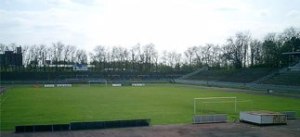 FK Spartak Zlatibor Voda – Subotica – Subotica City Stadium – Capacity: 28,000. Located in the north of Serbia close to the Hungarian border. The football club from Subotica that plays in the Serbian SuperLiga (Jelen Super Liga). The club was founded in 1945 and was named after Jovan Mikić Spartak, the leader of the Partisans in Subotica, and a national hero who was killed in 1944. The club was named FK Spartak Subotica until the end of season 2007-2008 Serbian League Vojvodina when it was merged with the club FK Zlatibor Voda who won promotion to Serbian First League thus gaining present name. Subotica City Stadium is a multi-use stadium in Subotica, Serbia. It is currently used mostly for football matches and is the home ground of FK Spartak Zlatibor Voda from 1945. The stadium holds 25,000 people. There is a football pitch and a registered track for athletics suitable for competitions. One part of the Stadium is covered.
FK Spartak Zlatibor Voda – Subotica – Subotica City Stadium – Capacity: 28,000. Located in the north of Serbia close to the Hungarian border. The football club from Subotica that plays in the Serbian SuperLiga (Jelen Super Liga). The club was founded in 1945 and was named after Jovan Mikić Spartak, the leader of the Partisans in Subotica, and a national hero who was killed in 1944. The club was named FK Spartak Subotica until the end of season 2007-2008 Serbian League Vojvodina when it was merged with the club FK Zlatibor Voda who won promotion to Serbian First League thus gaining present name. Subotica City Stadium is a multi-use stadium in Subotica, Serbia. It is currently used mostly for football matches and is the home ground of FK Spartak Zlatibor Voda from 1945. The stadium holds 25,000 people. There is a football pitch and a registered track for athletics suitable for competitions. One part of the Stadium is covered.
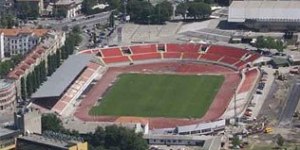 FK Vojvodina – Novi Sad – Karađorđe/ Novi Sad Stadium – Capacity: 17,200
FK Vojvodina – Novi Sad – Karađorđe/ Novi Sad Stadium – Capacity: 17,200
The club currently competes in the Serbian Superliga. FK Vojvodina is the oldest football club in Serbia’s elite league. Last season they finished runners up to Partizan. This was the first time a team other than Red Star or Partizan finished in the top 2 since 1998. The club’s biggest successes on the national level came during the SFRY when it won the Yugoslav First League in 1966 and 1989, and was the runner-up in 1957, 1962 and 1975. In 1967, Vojvodina reached the quarter-finals of the European Cup, before being knocked out in dramatic circumstances 2-1 on aggregate by eventual champions, Glasgow Celtic, courtesy of a last minute goal by Celtic captain Billy McNeill. The home field of FK Vojvodina is the Karađorđe Stadium in Novi Sad. With a capacity of 15,204 seats, it is the largest football stadium in the city. The stadium is also the home ground for the Serbian U-21 football team. In late May 2007, the stadium also was the site of Siniša Mihajlović’s testimonial match. In 2006, the club reconstructed the whole club complex SC Vujadin Boškov along with the stadium
FOOTBALL IN BELGRADE
Stadion Crevna Zvezda – The Red Star Stadium – 51,328 Capacity
 About Stadion Crvena Zvezda
About Stadion Crvena Zvezda
The Red Star Stadium or the Marakana as it has been more affectionately called since it opened is the most famous stadium in the Balkans. It is a traditional Eastern Bloc stadium built as a bowl, with an athletic track and the trademark prominent floodlights.
The stadium opened on the 1st September 1963, after the club and national team moved from the FK Novi Sad stadium which had been their home since 1927. Originally the capacity was around 75,000, and the biggest crowd the stadium saw was in autumn 1963 when Red Star played PK Partizan in front of over 77,000 spectators. During the next ten years the stadium was expanded to hold 110,000 with wooden benches covering the terraces. The stadium was originally very similar in appearance to the Zentraal stadium in Leipzig, and the Olympic Stadium in Kiev. In 1975 the stadium hosted its biggest ever club game as Red Star played the Hungarians Ferencvaros in the European Cup Winners Cup semi-final in front of a rumoured 108,000. The previous season the stadium had hosted the European Cup Final between Ajax and Juventus.
In 1976 the stadium hosted the semi-finals and final of the European Championships when Czechoslovakia upset the form guide by beating West Germany in the final. In the semi-final Yugoslavia lost to the Germans after extra time having led 2-0 for most of the game. The final historic game played in the stadium was in October 2005 when the old country of Serbia-Montenegro played their last ever game against Bosnia-Herzegovina before the country split into two. The stadium has some basic facilities for supporters, although the open bowl shape can make for some quite chilly conditions during the winter, despite the roof. The stadium also has a very good museum charting the progress of Red Star although the information is all in Serbian. The museum is open daily from 10am and is accessible from the main entrance of the stadium.
If you are in the city when Partizan are at home then you may want to catch a game there – the more intimate Stadium Partizana is located just north of the Red Star stadium and opposite the Tito Memorial complex. The ground holds around 30,000 although it is a very open stadium and so may be best avoided in the winter.
Who plays there?
The Red Star stadium is unsurprisingly the home to the Balkans most famous and successful club – Red Star Belgrade, or Crvena Zvezda as they are known now. The club are the current Serbian champions after winning the domestic double at a canter from their local rivals FK Partizan. They are also the only club from the former Yugoslavian states to have won the European Cup, which they did in 1991 by beating Marseille on penalties in Bari.
The final is one of the least remembered in modern times due to the negative tactics employed by Red Star in playing for penalties, which surprised most observers as they had played so well up until the final, including a 4-1 victory over Glasgow Rangers, 6-0 over Dynamo Dresden and a 4-3 win over Bayern Munich. Some of the most famous players in Yugoslavian football have pulled on the red and white shirt of Red Star including Siniša Mihajlovic, Robert Prosinečki, Dejan Savićević and Darko Pančev all of whom played in that final in Bari. The club won the Yugoslavian Championship on 18 occasions, as well as the Yugoslavian cup 12 times. Since the break-up of the country, they have won the Serbian Championship on 6 occasions, and the cup every year bar three. Aside from that famous night in Bari in 1991 they also won the World Cup Championship in Tokyo by beating Colo Colo of Chile 3-0.
For such a successful team it is amazing to think that they were only formed in 1945 after the Second World War had finished by a group of students from Belgrade University. The club were admitted into the Yugoslavian League in 1948, and won the Domestic cup in their first season. Since their 1991 European victory, the club has had little luck in UEFA competitions. In 1992 they needed a victory in their last game away in Anderlecht to reach the final again, but a 3-2 defeat coupled with Sampdoria’s draw meant the Italians reached the final. However since then they have failed to make it past the qualifying stages, and have been surpassed in achievement by Partizan who have reached the Group Stages. However, in the 2007/08 Champions League they should at least reach the final Qualifying round with a game against the Estonian champions TMVK in round 2 in August.
Another part Red Star’s stadium has had in history was that it was the venue of Manchester United’s last game before the Munich air crash in 1958. The rivalry between Red Star and Partizan has certainly been intensified over the past decade or so. During the Balkans war the clubs took on an almost paramilitary significance and games between the two almost always ended in violence on the terraces.
How to get there
The stadium is located in the south of the city, close to the E70 Motorway and in the heart of a nice middle-class residential area, characterised by smart detached houses with swimming pools. It is also close enough to the Central Station and Bus Station to be walk able. However, the Tram lines 2, 7 and 9 pass within 200metres of the stadium from the Station if you don’t feel like the walk down Nemanjina to the stadium. If you are going to see Partizan then you can follow these direction as well as the stadium is located less than 500 yards north of Red Star’s stadium.
The Partizan Stadium – 30,887 All Seater

Home to Partizan Belgrade. Last season the club were expelled from teh UEFA Cup after the fans rioted at a game in Bosnia. Recently they have been very vocal in their demonstrations against the arrest of Bosnian Serb leader Radovan Karadzic.
Getting a ticket
Domestic football is not the best supported league in Europe to say the least. With a capacity of over 50,000 you will rarely see attendances over 7,000 for a league match, although attendances for games against FK Partizan can often attract over 30,000. However, whatever the game you will not have a problem picking up a ticket on the day. Ticket prices start from 20 Dinar for a place in the cheap seats, although it is best to avoid the hardcore Red Star fans behind the goal.
For National team games then tickets can be purchased in advance from the Serbian FA on +381 11 323 3447, email fsj@beotel.yu or via http://www.tiketservis.com. For Partizan games check out their website at http://www. Partizan.net.
Getting around
Public transportation in Belgrade is cheap and plentiful if not comfortable. The main methods of getting around are buses and trolley buses. Pick up a route map from the Tourist Information Centre and then simply buy a ticket from the kiosks in the street for 27 dinars, or for 40 dinars from the driver.
Nearest Airport – Belgrade Nikola Tesla (BEG)
Telephone: +381 11 209 4000
Website: http://www.beg.aero
The busiest airport in Serbia is located around 11 miles west of the city centre in the small town of Surčin. British Airways and JAT Airways both fly daily from London Heathrow to Belgrade.
The easiest way to reach the city centre from the airport is by the Jat Airways coach which departs every hour to Slavija Square and the Central Railway Station. The fare is 160 dinars. Alternatively Bus Line 72 runs to the Station takes around 25 minutes and costs 35 dinars. A taxi will cost €9 for a fixed fee and should take 20 minutes – only used licensed taxis only though or book one on arrival by dialling 970 or texting to 9700.
The city has a comprehensive network of buses, trams and trolleybuses. Tickets cost 40 dinar for a single journey – make sure you punch your ticket when you board otherwise you can be fined up to €50. The major transport hubs are in Trg Republike and Trg Slavija.
Our last visit – May 2012
Our carriage is bathed in sunshine, streaming through the window and lighting up Andy’s arse like a beacon. We have arrived in Belgrade. At some point in the night we awoke to find two policemen with machine guns and dogs in our carriage but assumed that was something to do with the smell. If only the aroma could be bottled and sold on the markets of Essex we would be millionaires.
We were met at Belgrade station by all round top man Nenard. This man could body double for Hagrid if they ever fancied doing a Serbian remake of Harry Potter and the Derby Tickets (Хари Потер и Дерби Улазнице if you asked). He guided us through the essentials such as taking £80 out of the cashpoint and not the £8 we had just got (Belgrade is cheap but not that cheap), how to avoid ticket inspectors on the trams and buses, and of course how to find magic doors. First stop, of course, was a ground. Home of FK Rad in the Belgrade suburbs just to wet our appetite. Second stop, his house to sate that very appetite with a spread laid on by his Mum that was outstanding.
This was hospitality of the top order. His Mum couldn’t speak any English yet made sure we were fed, water and fed again before going out on the beers. Breakfast has more meat than you could shake a stick at, homemade grape brandy and something called Lazy Cake which filled a hole the size of Greece’s Euro debt.
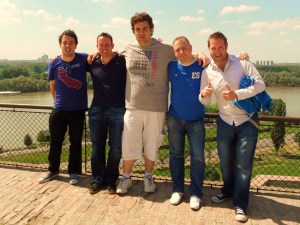 We waved goodbye to our host and headed off into the big city lights for a pleasant day of sightseeing, sunshine and of course more than a few beers.
We waved goodbye to our host and headed off into the big city lights for a pleasant day of sightseeing, sunshine and of course more than a few beers.
Everything you have heard about Belgrade is true. Yes, the women are stunning. Yes, the city still shows scars from the conflicts twenty years ago, and yes beer is indeed £1.20 a bottle. We sat on the terrace of the Kalemegdan Citadel for a few hours discussing Eighties music, life in Serbia and of course football before Andy’s pasty northern chest couldn’t take it anymore and he went and sat in the shade. But it was football time, and a short cab ride later (in a 20 year old Lada) saw us paying 400 Serbian Dinar (£2.80) to enter the OFK Stadion for our first slice of Serbian Super League action.
Game 3 – OFK Belgrade 2 Metalac GM – Saturday 5th May 2012 – Omladinski Stadion
Midtable v bottom in most top leagues in Europe may generate a few thousand fans. But in Serbia there really is only Partizan and Red Star. Despite only being a few points off a Europa League game there was less than 100 fans in the crumbling 19,000 capacity Omladinski stadium. The club actually played in the Europa League in 2010 at the stadium which just shows the farce of ground grading in England that a stadium where there are no floodlights, no food facilities and unsafe terraces. But safe it was deemed by UEFA who allowed Galatasaray to travel here in the 3rd qualifying round last year and won 5-1 in front of over 6,000 fans.
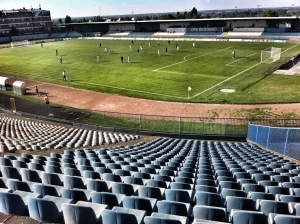 But today in the sunshine there was about 60 here, and apart from a dozen or so noisy home fans it seemed like the only atmosphere came from the toilet block in the corner that should have been condemned a long time ago. I have no idea how clubs can make money at this level. Gate receipts could not have topped £250 – who pays the players, the officials et al? There wasn’t even a club shop selling OFK slippers!
But today in the sunshine there was about 60 here, and apart from a dozen or so noisy home fans it seemed like the only atmosphere came from the toilet block in the corner that should have been condemned a long time ago. I have no idea how clubs can make money at this level. Gate receipts could not have topped £250 – who pays the players, the officials et al? There wasn’t even a club shop selling OFK slippers!
We only had time for a quick Souness, needing some food before the big one. Another Lada later and we were in a bar on the other side of town, ticket for the derby in hand and feeling very good with life. It was showtime!
Game 4 – Partizan Belgrade 0 Red Star Belgrade 1 – Saturday 5th May 2012 – Partizan Stadium
Let’s face it – who wouldn’t have wanted to be in the thick of thousands of fanatical fans holding up their flares at this one? Well, having suffered with a chest infection for a week, it wasn’t the wisest idea for me to be taking in huge lung-fulls of acrid smoke, but that is why God created Amoxicillin right? Once you have experienced the atmosphere at one of these games you cannot wait for your next fix. It is like a drug and your dealer is Danny Last.
The police presence around the ground was organised and very visible. The riot police had been deployed in units of ten at almost every junction, meaning a very quick reaction to any trouble if it kicked off. Entry into the ground was also smooth without any of the hassle we have experienced elsewhere in the world.
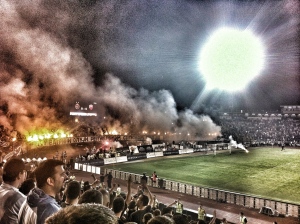 So to the game itself. Partizan had won the league the previous week and had agreed to keep any celebrations low-key in such a tinderbox atmosphere. Fat chance of that with the fans organising their own celebration with banners mocking their opponents as well as more than a few digs at manager Avram Grant. Ah, Avram (and by digs I mean coins, lighters and kitchen sinks being thrown at him as he exited the pitch at half time). How we miss your wonderful cheery personality and clueless tactics from East London. It is good to see you retain your popularity oversees.
So to the game itself. Partizan had won the league the previous week and had agreed to keep any celebrations low-key in such a tinderbox atmosphere. Fat chance of that with the fans organising their own celebration with banners mocking their opponents as well as more than a few digs at manager Avram Grant. Ah, Avram (and by digs I mean coins, lighters and kitchen sinks being thrown at him as he exited the pitch at half time). How we miss your wonderful cheery personality and clueless tactics from East London. It is good to see you retain your popularity oversees.
The game itself wasn’t a classic. In fact it was a shocker. Neither team could improve their league position and so with Champions League qualification already sorted it became a bit of a bore draw, only livened up by the antics of the fans at either end. In fact you could have quite easily suggested (as we did) that a 0-0 draw had been agreed beforehand just to keep all of the natives happy.
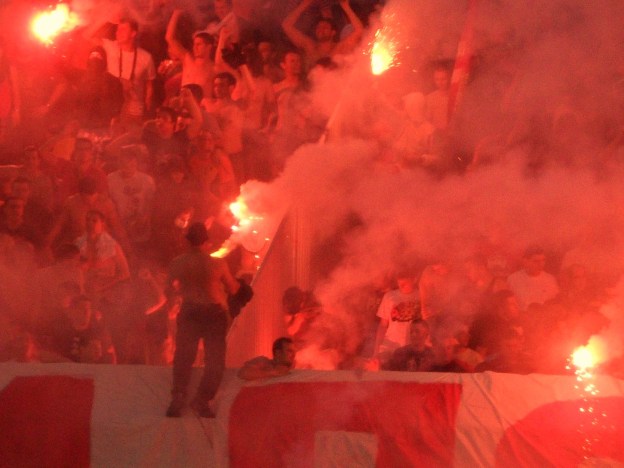 But then just as we were looking forward to a quiet night in the town centre, Red Star’s Cadu popped up and scored in the third minute of injury time. To say the place went mad is a bit of an understatement. All of a sudden the Red Star fans flowed onto the running track, mobbing the players. The brave referee tried to get them back to restart the game but after a few more seconds of play he called time on proceedings and ran for cover.
But then just as we were looking forward to a quiet night in the town centre, Red Star’s Cadu popped up and scored in the third minute of injury time. To say the place went mad is a bit of an understatement. All of a sudden the Red Star fans flowed onto the running track, mobbing the players. The brave referee tried to get them back to restart the game but after a few more seconds of play he called time on proceedings and ran for cover.
Queue even more celebrations from the Red Star players in front of their fans. It was as if they had won the league, rather than just the bragging rights for the last meeting of the season. Players, some almost stripped naked by the fans sprinted for the tunnel and the away fans decided to set fire to a few seats to celebrate.
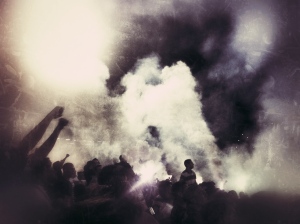 Again, organisation outside the stadium was efficient and we saw no hint of trouble. In fact within thirty minutes of the final whistle we were back in the bar with Red Star’s biggest fans (Nenard and of course Andy Hudson). For all the colour of the game click here.
Again, organisation outside the stadium was efficient and we saw no hint of trouble. In fact within thirty minutes of the final whistle we were back in the bar with Red Star’s biggest fans (Nenard and of course Andy Hudson). For all the colour of the game click here.
A few more two pound beers (we were paying the premium for drinking in the Irish Bar by this point) and it was time to bid Belgrade a good night, ready for what tomorrow would throw at us.
Day three of the adventure began with a civilised breakfast. It was voting day in the Serbian Elections and our choice of candidate Jadranka Šešelj (purely on looks I hasten to add) although after we discovered her husband is on trial at The Hague for war crimes we revoked our support and hoped that politics was the winner instead. For us it was more football (of course it was), starting off with a trip to watch FK Belgrade in the third division.
Game 5 – FK Belgrade 2 PBK 2 – Sunday 6th May 2012 – Somewhere in Belgrade
There are few grounds in the world where there is little point in charging people to get in, but this was one. At either end of the ground were tall blocks of flats, offering perfect views of the game to any residents. On one side was a grass bank where at the top, through a magic door, came the fans in their droves for this Sunday morning game.
Apart from a makeshift wooden structure that could seat three old chaps, everyone else stood up. I couldn’t see the logic in this – the grass was dry, it was in the sunshine and soon enough those Енглисх будале (English fools) were lolling around on the floor. I mean it wasn’t as if we ended up falling down the bank or anything remotely embarrassing. This was level three in Serbian football, and if I was going to have to compare it to anywhere in England, Whitehawk from the Ryman League would come to mind, although the caravan park doesn’t really translate well in Serbian.
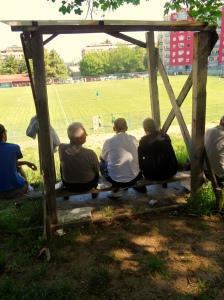 The officials led the teams out of a little house in the corner of the ground – hang on – here was a first. A female referee and a linesman. The latter certainly pulled off the whole “woman in football kit” look from our vantage point. All three officials (and let’s big up Mr Linesman here too) allowed the game to flow and it was certainly an enjoyable Sunday morning run out. However, one is never enough on these trips, so before you could say Време аддед он we were off, hailing down a taxi to take us across the city to the Zârkovo for their game.
The officials led the teams out of a little house in the corner of the ground – hang on – here was a first. A female referee and a linesman. The latter certainly pulled off the whole “woman in football kit” look from our vantage point. All three officials (and let’s big up Mr Linesman here too) allowed the game to flow and it was certainly an enjoyable Sunday morning run out. However, one is never enough on these trips, so before you could say Време аддед он we were off, hailing down a taxi to take us across the city to the Zârkovo for their game.
So off we went, driving past the new bridges over the rivers that were destroyed by the NATO bombs in the early Ninties, waving a “hello” at the World Rowing Championships (“Go Team GB” or something) before the taxi driver turned with a confused look. He simply couldn’t find the ground. “That’s no problem – we can ask Google Maps”. Oh how this would bite me on the arse later.
But for now we located the ground, paid the cab and went in search of game number 6. Except game number six wasn’t there. Nothing was there. The ground was just empty. Step up Uncle Google – there was the ground about “5 minutes on the right”. Twenty minutes later and still no game. To shorten a long story we never did find the ground or the game despite Google’s help. Time for lunch then and a plan B.
Plan B was a visit to Red Star’s Marakana stadium, the spiritual home of football in what used to be Yugoslavia. Once the stadium literally shook to the sound of over 100,000 fans on regular occasions, making it one of the most intimidating places for visiting teams to come to. The infamous Busby Babes team of 1958 played their final game before the Munich Air Crash here in 1958; The 1973 European Cup final played here saw the legendary Ajax team beat Juventus and in 1976 it hosted the finals of the European Championship, won by Czechoslovakia. But it was closed.
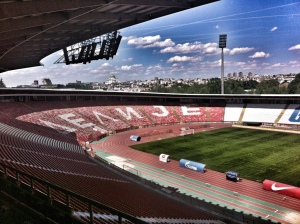 Closed is not a word in our vocabulary. Just ask the question is our mantra and our response was that for a price (£8.33 to quote latest exchange rates), the door not only to the stadium, but also the press area and the Executive lounges swung wide open. Hello boys.
Closed is not a word in our vocabulary. Just ask the question is our mantra and our response was that for a price (£8.33 to quote latest exchange rates), the door not only to the stadium, but also the press area and the Executive lounges swung wide open. Hello boys.
So what does one do when you have got into one ground? Try another of course, and so we set off down the hill to Partizan’s stadium. The two grounds are separated by about 500 yards in one of the closest top level rivalries in European football. The clear up operation was in full effect and so we decided it was beer o’ clock and headed into the courtyard adjoining the ground. Hello, what’s this? Of course – a magic door and even a guide to boot who didn’t need a top up on his pension.
As we left we saw a troop of players leaving the stadium, all kitted up. Partizan Under 18’s no less off to play a game in the Military stadium just down the road. Well, it would be rude not to drop in on that one, although we have no idea who they were playing and what the score was so I am loathed to count that as number six for the weekend.
The rest of the day was spent wandering the sites of the city, a beer, some Serbian food, a beer, a little rest, a beer and so on until that 4am wake up call drew us back to the hotel. Serbia had been a fantastic experience, with hospitable people, prices to make you rub your eyes and a derby day experience that is up there with the best in the world. Yes please. Oh – one word of warning. Despite what you may believe, Serbia is no longer in Europe – well, that is according to T-Mobile. After landing at London Luton (and having a spare hour waiting to get through UK Border) I checked my phone usage. £670 in mobile roaming charging in TWO DAYS! This is because Serbia is not included in T-Mobile’s European data pack which I subscribe to AND would have warned me when I get to a certain threshold. But no – according to T-Mobile the use of apps like Google Maps (as used on Sunday morning) this data was not included. Be warned!
Your history of foodball is reasonable correct. However your general knowledge of history is TRAGICAL.
Did you learn history from Tony Blair’s not published book or let me ask you differently: “Where did you find that by the 16th century Serbian lands were conquered and occupied by Ottomans…”?
If you insist on British historians I would suggest you to read: “A history of medieval Serbia, 1167 to 1389” by Paul Moon. From many other British historians you could learn that on Saint Vitus Day, Tuesday June 15th 1389 Serbian army lost the bettle on Kosovo field by Ottomans and Orthodox Serbs became slaves of the Muslims
The expansion of that Ottoman state, and increasingly frequent Turkish raids into his land, warned Prince Lazar that the time for a decisive battle was drawing near. Lengthy preparation on both sides preceded this confrontation. The fact that the armies were led by the Turkish ruler Murad 1 and by King Lazar of Serbia illustrates the importance of this battle. It was decided that the site of the battle would be a field in Kosovo (Kosovo Polje).
Prince Lazar knew that his chances against the Turkish aggressor were small and on the eve of the Battle of Kosovo he gathered his upper aristocracy and asked if they should fight for the Holy cross and Golden Freedom or surrender to their adversaries and live as slaves of the Muslims. They had to chose between the Heavenly Kingdom and earthly one. In the true spirit of Christianity they preferred to place their hope in Christ and Eternal Life. The Serbian Prince and all of his warriors took Holy communion and went into battle on Saint Vitus Day, Tuesday June 15th 1389.
This is what the beggest ever lier and criminal Tony Blair wanted never to be known as well as HIS real resons to lead the NATO (North Atlantic Terrorist Organisation)forces in relentless blitzkrieg with 23,000 “dumb” bombs and “smart” missiles rained upon Serbia for 79 days.
All the best,
Antifashist and antiblairist
Fantastic website. Plenty of useful information here. I am sending it to some friends ans additionally sharing in delicious. And certainly, thank you to your effort!